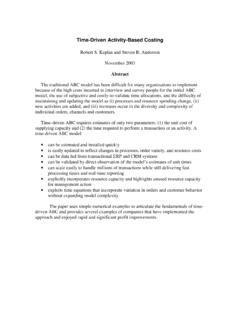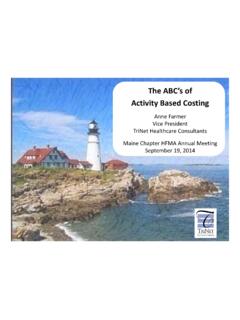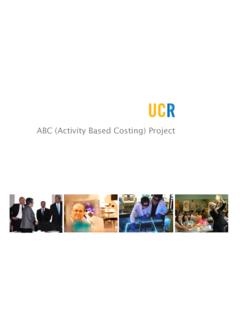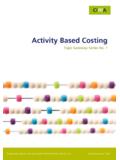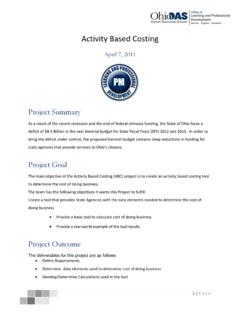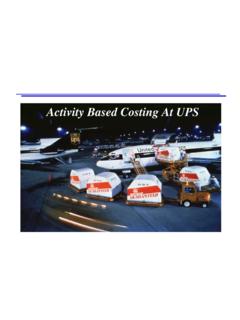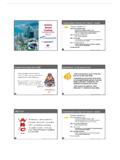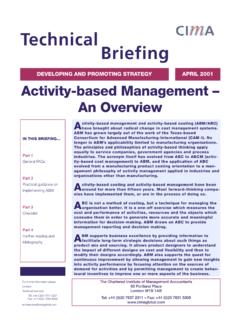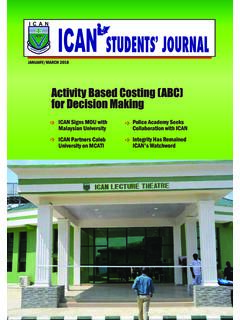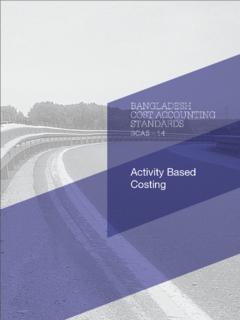Transcription of Course-Level Activity-Based Costing as an Academic and ...
1 Course-Level Activity-Based Costing as an Academic and Financial ToolWilliam F. Massy, Stanford University 2 Course-Level Activity-Based Costing as an Academic and Financial ToolAbout this ResearchThis paper is one of five in the TIAA Institute Higher Education Series: Understanding Academic Productivity, an initiative undertaken in support of NACUBO s Economic Models Project. That project was launched by NACUBO with the aim to provide colleges and universities with knowledge, ideas and tools to advance the difficult structural, cultural and political changes required for moving to more sustainable economic models.
2 Given NACUBO s goal of offering thoughtful, objective and credible scholarship on the issues at hand, the TIAA Institute was a natural partner for the project. This paper, written by William Massy, former Vice President for Business and Finance (among other senior positions) and emeritus professor at Stanford University, offers an in-depth description of an enhanced Activity-Based Costing (ABC) tool by way of a case study of its implementation at the University of California Riverside. Massy notes the partnership between the provost and CFO there as critical to the success and ongoing refinement of the project, and shares key information to help senior campus leaders assess the value of the enhanced ABC tool for their the TIAA InstituteThe TIAA Institute helps advance the ways individuals and institutions plan for financial security and organizational effectiveness.
3 The Institute conducts in-depth research, provides access to a network of thought leaders and enables those it serves to anticipate trends, plan future strategies and maximize opportunities for success. To learn more, visit NACUBONACUBO, founded in 1962, is a nonprofit professional organization representing chief administrative and financial officers at more than 2,100 colleges and universities across the country. NACUBO s mission is to advance the economic viability, business practices and support for higher education institutions in fulfillment of their missions.
4 For more information, visit Course-Level Activity-Based Costing as an Academic and Financial Tool 1 Executive SummaryDelivery of quality education in a budget-constrained environment requires that Academic and financial decision-makers understand the activities, costs and margins associated with teaching at the course level. Working in partnership, the provost and CFO at the University of California - Riverside (UCR) have implemented an enhanced Activity-Based Costing (ABC) tool to supply this The tool integrates data from the university s enterprise systems with survey responses from faculty and/or department chairs to estimate, for each course in the curriculum, teaching activity profiles, resource utilization and financial outcomes, and rough quality surrogates.
5 Short-term benefits include assessing resource allocation strategies and prioritizing budget alternatives, quantifying the levels of cross-subsidization across the institution, gaining deeper insights about course redesign, and improving human resource and facilities utilization. Longer term, the goal is to transform how departments think about optimizing cost in relation to resource utilization and education quality. This essay discusses the reasons for developing the model, outlines its conceptual structure, illustrates the kinds of information it provides, and describes some ways it will be used in Academic planning and Takeaways While course content remains paramount for faculty, achieving the university s mission in today s world also requires attention to teaching processes, costs and margins.
6 Faculty and other academics should be provided with the tools and knowhow needed for assessing the trade-offs between cost and quality, and the efficacy of cross-subsidies among courses and departments, because administrators themselves cannot do that job effectively. The development of such tools was not possible until recent advances in university enterprise systems (especially timetabling and student registration systems), and now only modest supplementary data need be generated by survey. The familiar aggregate metrics for assessing teaching productivity (such as cost per credit hour) for courses, departments, degree programs, etc.
7 , are readily calculated from the enhanced ABC tool, but in a way that helps faculty improve their offerings rather than focusing on accountability and risking a race to the bottom in terms of quality. To be successful, the deployment of such tools requires active championing by Academic leaders (in UCR s case, the provost) as well as financial The author wishes to acknowledge the contributions of Paul D Anieri and Maria Anguiano, the provost and CFO, respectively, at the University of California-Riverside (UCR). Implementation of the enhanced ABC tool at UCR would not have been possible without their partnership and commitment to this effort.
8 Copyright 2016 by the author. Do not cite or quote without the permission of the author. Any opinions expressed herein are those of the author, and do not necessarily represent the views of TIAA, the TIAA Institute or any other organization with which the author is paper is one in a series of five focusing on productivity and new economic models for higher series offers a deeply-informed review of the literature, a two-part examination of higher education s contributions to the public good, an assessment of state-level efforts to measure productivity.
9 And an in-depth description of a course- based tool to analyze Course-Level Activity-Based Costing as an Academic and Financial ToolA growing California student population worthy of a top-flight university education in an era of reduced state funding made it an imperative for the University of California - Riverside (UCR) to better understand its costs in order to effectively scale student instruction. The provost and CFO at the University of California - Riverside joined forces to implement an enhanced Activity-Based Costing (ABC) model and software tool that provides detailed revenue and cost data at the course level.
10 The tool reports the activities, costs, and revenues associated with the course portfolio and other university functions, which gives both Academic and financial decision-makers better insight into their planning and budgeting options. For example, chairs and deans can do better in choosing the most appropriate mix of instructional models given their resource constraints, and demonstrate the efficacy of their choices. These objectives follow the spirit of the TIAA Institute s recent paper on how better data can improve institutional decision-making [Soares, Steele, and Wayt, 2016].

